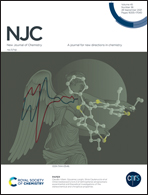In situ synthesis of a hybrid Fe(Co)/MXene/ZSM-5 catalyst for phenol abatement†
Abstract
Sulfate radical based photocatalysis is recognized as an effective approach for the photodegradation of organic pollutants in wastewater. To overcome the defects of weak visible light absorptivity and low catalytic efficiency of ZSM-5 based catalysts, MXene (Ti3C2) and a dopant were introduced to develop the multifunctional photocatalyst Metal/MXene/ZSM-5 by a modified in situ hydrothermal method, which was applied to phenol degradation under simulated solar light. The crystal growth, morphology, and structure of the prepared catalysts were systematically characterized by X-ray diffraction, scanning electron microscopy, surface area measurements, and various spectroscopy methods (UV-Raman, X-ray photoelectron, and UV-visible diffuse reflectance spectroscopies). The heterostructure of Fe(II)/Fe(III)/TiO2 in 5%Fe/5%MXene/ZSM-5 reduces the band gap and improves the visible light absorptivity, leading consequently to improved phenol photocatalytic degradation efficiency. The effects of pH, reaction temperature, initial phenol concentration, and peroxymonosulfate dosage on the catalytic performance of 5%Fe/5%MXene/ZSM-5 and the production of free active radicals in the 5%Fe/5%MXene/ZSM-5/PMS system were then investigated. 5%Fe/5%MXene/ZSM-5 achieves an efficient catalytic activity with over 98% removal of phenol within 25 min and 1O2 and ˙O2− radicals are the dominant reactive radicals in the 5%Fe/5%MXene/ZSM-5/PMS system for phenol degradation. This investigation improves the photocatalytic efficiency of the ZSM-5 zeolite-based catalyst under simulated sunlight.



 Please wait while we load your content...
Please wait while we load your content...